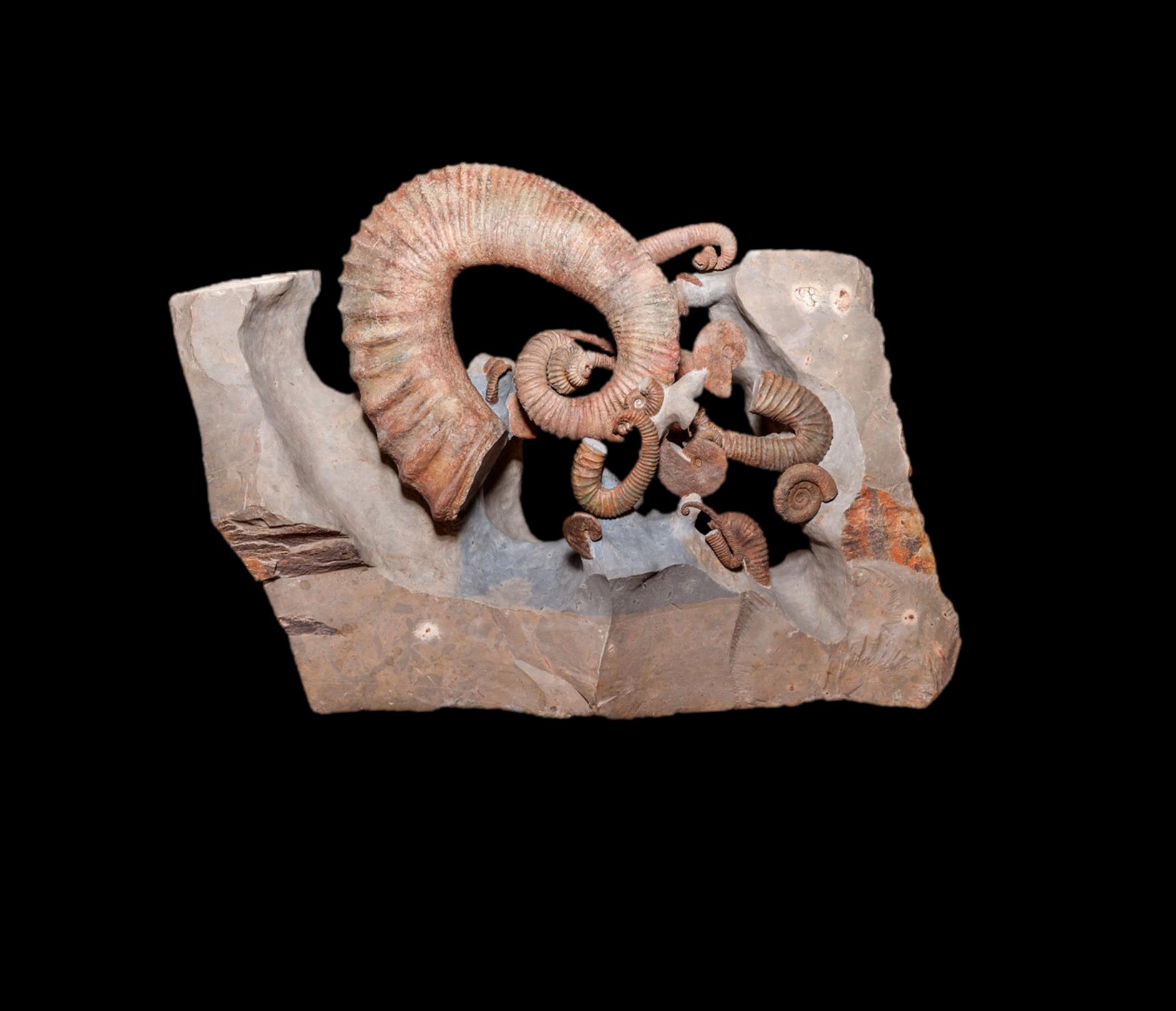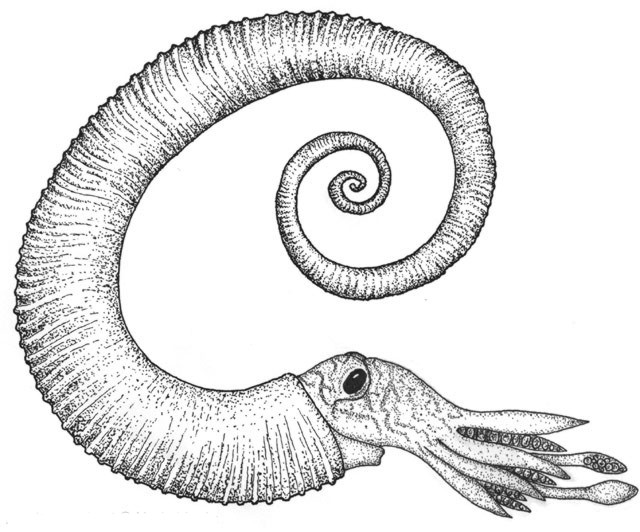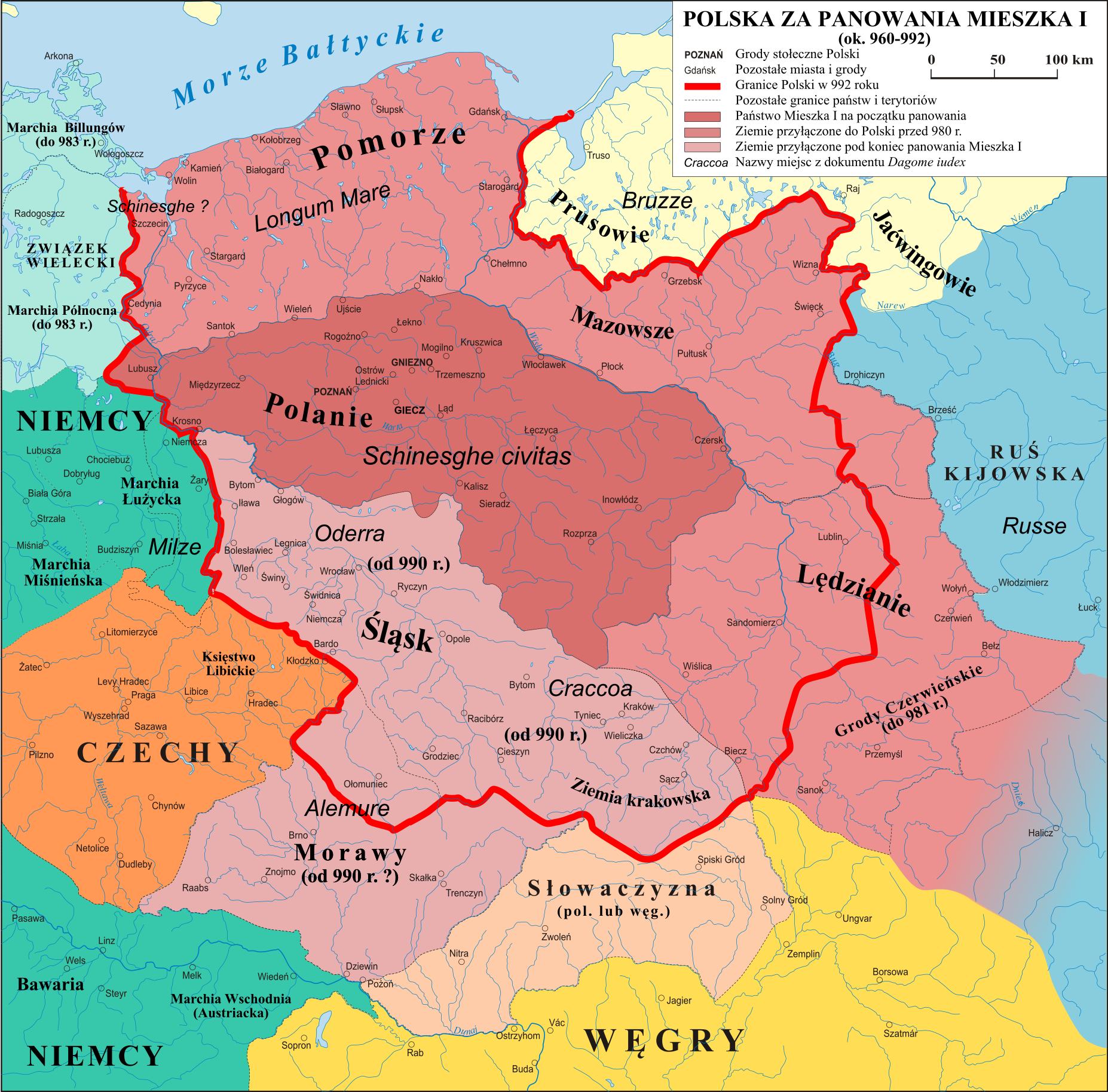|
Baculitidae
Baculitidae is a family of extinct Ammonoidea, ammonoid cephalopods that lived mostly during the Late Cretaceous, and often included in the suborder Ancyloceratina. Baculitid genera are characterized by a small to minute initial coil of about two whorls followed by a long straight or slightly curved shaft. Genera are distinguished on the basis of size, general shape, particulars of the suture, and ornamentation. They can reach lengths of or more. Baculitids are found worldwide in deposits from the upper Albian to the Maastrichtian ages. Related families are the Anisoceratidae, Diplomoceratidae, Hamitidae, Nostoceratidae, and Turrilitidae; all of which along with the Baculitidae are included in the superfamily Turrilitoidea. Genera included in the family include: *''Baculites'' *''Boehmoceras'' *''Eubaculites'' *''Euhomaloceras'' *''Fresvillia'' *''Lechites (genus), Lechites'' *''Pseudobaculites'' *''Sciponoceras'' *''Tuberosciponoceras '' References External links The Pa ... [...More Info...] [...Related Items...] OR: [Wikipedia] [Google] [Baidu] |
Baculites
''Baculites'' ("walking stick rock") is an extinct genus of cephalopods with a nearly straight shell, included in the heteromorph ammonites. The genus, which lived worldwide throughout most of the Late Cretaceous, and which briefly survived the K-Pg mass extinction event, was named by Lamarck in 1799. Life Shell anatomy The adult shell of ''Baculites'' is generally straight and may be either smooth or with sinuous striae or ribbing that typically slant dorso-ventrally forward. The aperture likewise slopes to the front and has a sinuous margin. The venter is narrowly rounded to acute while the dorsum is more broad. The juvenile shell, found at the apex, is coiled in one or two whorls and described as minute, about in diameter. Adult ''Baculites'' ranged in size from about (''Baculites larsoni'') up to in length. As with other ammonites, the shell consisted of a series of camerae, or chambers, that were connected to the animal by a narrow tube called a siphuncle by which ... [...More Info...] [...Related Items...] OR: [Wikipedia] [Google] [Baidu] |
Turrilitoidea
Turrilitoidea is a diverse superfamily of Cretaceous ammonites generally considered as heteromorphic and commonly included in the suborder Ancyloceratina. Shells of this diverse group do not coil planospirally, as typical for most ammonitida, ammonites, but rather take on a variety of unique forms. Separation of Turrilitoidea along with Ptychoceratoidea and Scaphatoidea into a different suborder, Turrilitina, was proposed by Beznosov and Mikhailova in 1983 however this view is not accepted by most authors. Some, such as the eponymous ''Turrilites'', coiled helically, like an auger shell, while others, such as ''Hamites (genus), Hamites'', had shells with long straight sections, while the one-of-a-kind ''Nipponites'' coiled in a way so as to appear as a ball of knots. As with other ammonites, the last of the Turrilitoidea had perished by the end of the Cretaceous during the Cretaceous–Paleogene extinction event. References * Arkell ''et al.'', 1957. Mesozoic Ammonoidea,' ... [...More Info...] [...Related Items...] OR: [Wikipedia] [Google] [Baidu] |
Ancyloceratina
The Ancyloceratina were a diverse suborder of ammonite most closely related to the ammonites of order Lytoceratina. They evolved during the Late Jurassic but were not very common until the Cretaceous period, when they rapidly diversified and became one of the most distinctive components of Cretaceous marine faunas. They have been recorded from every continent and many are used as zonal or index fossils. The most distinctive feature of the majority of the Ancyloceratina is the tendency for most of them to have shells that are not regular spirals like most other ammonites. These irregularly-coiled ammonites are called heteromorph ammonites, in contrast to regularly coiled ammonites, which are called homomorph ammonites. Biology The biology of the heteromorph ammonites is not clear, but one certainty is that their uncoiled shells would have made these forms very poor swimmers. Open shells, particularly ones with spines and ribs, create a lot of drag; but more importantly, the orient ... [...More Info...] [...Related Items...] OR: [Wikipedia] [Google] [Baidu] |
Fresvillia
''Fresvillia'' is an extinct cephalopod genus belonging to baculitid family of the ammonoid order Ancyloceratida that lived during the Late Cretaceous, found in France. Baculitids are a kind of heteromorph The Ancyloceratina were a diverse suborder of ammonite most closely related to the ammonites of order Lytoceratina. They evolved during the Late Jurassic but were not very common until the Cretaceous period, when they rapidly diversified and bec ... ammonite characterized by a straight adult shaft, often preceded by a small coiled juvenile portion. '' Baculites'', '' Boehmoceras'', '' Eubaculites'', and '' Lechites'', are among related genera. References Fresvillia-Paleodb Ammonitida genera Turrilitoidea Late Cretaceous ammonites Fossils of France {{ammonitida-stub ... [...More Info...] [...Related Items...] OR: [Wikipedia] [Google] [Baidu] |
Hamitidae
''Hamites'' (":wikt:Hamites, hook-like") is a genus of heteromorph ammonite that evolved late in the Aptian stage of the Early Cretaceous and lasted into the Cenomanian stage of the Late Cretaceous. The genus is almost certainly paraphyletic but remains in wide use as a "catch all" for heteromorph ammonites of the superfamily Turrilitoidea that do not neatly fit into the more Synapomorphy, derived groupings. In an attempt to identify clades within the genus, it has been divided up into a series of new genera or subgenera by different Paleontology, palaeontologists, including ''Eohamites'', ''Hamitella'', ''Helicohamites'', ''Lytohamites'', ''Planohamites'', ''Psilohamites'', and ''Sziveshamites''. The type species is ''Hamites attenuatus'' from the early Albian, named by James Sowerby in his ''Mineral Conchology of Great Britain'' of 1814, although the genus itself was created by James Parkinson in his 1811 book ''Organic Remains of the Former World''. This James Parkinson is bes ... [...More Info...] [...Related Items...] OR: [Wikipedia] [Google] [Baidu] |
Eubaculites
''Eubaculites'' is an extinct genus of cephalopods in the family Baculitidae and each known species was initially placed within the related genus '' Baculites'' until it was placed in a separate genus in 1926. ''Eubaculites'' existed from the Turonian until the Danian, and is one of the very last species of ammonites, going extinct roughly 64.5 million years ago, which was around 500,000 years after the start of the Cenozoic. Specimens found in the Maastricht Formation in The Netherlands suggest that at least one species (''E. carinatus'') survived the K-Pg mass extinction event, albeit being restricted to the Danian The Danian is the oldest age or lowest stage of the Paleocene Epoch or Series, of the Paleogene Period or System, and of the Cenozoic Era or Erathem. The beginning of the Danian (and the end of the preceding Maastrichtian) is at the Cretaceous†.... References Prehistoric cephalopod genera Ancyloceratina Fossil taxa described in 1926 {{Cephalopo ... [...More Info...] [...Related Items...] OR: [Wikipedia] [Google] [Baidu] |
Albian
The Albian is both an age of the geologic timescale and a stage in the stratigraphic column. It is the youngest or uppermost subdivision of the Early/Lower Cretaceous Epoch/Series. Its approximate time range is 113.0 ± 1.0 Ma to 100.5 ± 0.9 Ma (million years ago). The Albian is preceded by the Aptian and followed by the Cenomanian. Stratigraphic definitions The Albian Stage was first proposed in 1842 by Alcide d'Orbigny. It was named after Alba, the Latin name for River Aube in France. A Global Boundary Stratotype Section and Point (GSSP), ratified by the IUGS in 2016, defines the base of the Albian as the first occurrence of the planktonic foraminiferan '' Microhedbergella renilaevis'' at the Col de Pré-Guittard section, Arnayon, Drôme, France. The top of the Albian Stage (the base of the Cenomanian Stage and Upper Cretaceous Series) is defined as the place where the foram species '' Rotalipora globotruncanoides'' first appears in the stratigraphic column. The Albia ... [...More Info...] [...Related Items...] OR: [Wikipedia] [Google] [Baidu] |
Ammonitida Families
Ammonitida is an order of Ammonoidea, ammonoid cephalopods that lived from the Jurassic through Paleocene time periods, commonly with intricate ammonitic sutures. Ammonitida is divided into four suborders, the Phylloceratina, Lytoceratina, Ancyloceratina, and Ammonitina. The Phylloceratina is the ancestral stock, derived from the Ceratitida near the end of the Triassic. The Phylloceratina gave rise to the Lytoceratina near the beginning of the Jurassic which in turn gave rise to the highly specialized Ancyloceratina near the end of the Jurassic. Both the Phylloceratina and Lytoceratina gave rise to various stocks combined in the Ammonitina. These four suborders are further divided into different stocks, comprising various families combined into superfamilies. Some like the Hildoceratoidea and Stephanoceratoidea are restricted to the Jurassic. Others like the Hoplitoidea and Acanthoceratoidea are known only from the Cretaceous. Still others like the Perisphinctoidea are found ... [...More Info...] [...Related Items...] OR: [Wikipedia] [Google] [Baidu] |
Lechites (genus)
Lechites (, german: Lechiten), also known as the Lechitic tribes (, german: Lechitische Stämme), is a name given to certain West Slavic tribes who inhabited modern-day Poland and eastern Germany, and were speakers of the Lechitic languages. Distinct from the Czech–Slovak subgroup, they are the closest ancestors of ethnic Poles and the Pomeranians, Lusatians and Polabians. History According to Polish legend, Mieszko I inherited the ducal throne from his father who probably ruled over two-thirds of the territory inhabited by eastern Lechite tribes. He united the Lechites east of the Oder (Polans, Masovians, Pomeranians, Vistulans, Silesians) into a single country of Poland. His son, Bolesław I the Brave, founded the bishoprics at Wrocław, Kołobrzeg, and Kraków, and an archbishopric at Gniezno. Bolesław carried out successful wars against Bohemia, Moravia, Kievan Rus' and Lusatia, and forced the western Pomeranians to pay Poland a tribute. Shortly before his death B ... [...More Info...] [...Related Items...] OR: [Wikipedia] [Google] [Baidu] |



